The Story of NASA’s Most Powerful Rocket: Understanding the SLS Could Make You Love It Even More!
The media has dubbed NASA’s delay of the SLS launch as a “great setback.” Few are aware that the two incidents causing the delay of the most powerful rocket in NASA’s history are just minor challenges in the decades-long construction journey of the SLS.
“The Mother of All Space Launch Vehicles” – is how David Beaman, the Director of NASA’s SLS Technical & Integration Office, refers to the upgraded future version of the SLS rocket (known as Block 2) – highlighting the immense hope that NASA and thousands of its brains have placed in the SLS launch system.
The slight difficulties and delays faced by NASA illustrate the agency’s meticulous pursuit of perfection for its latest rocket system.
To gain a clearer understanding, National Geographic published a lengthy article discussing the challenges surrounding the SLS from its inception, and how, to this day, it stands tall on launch pad 39B at Kennedy Space Center in Florida, ready to fly and usher in a new era of space exploration known as the Artemis Era.
If there comes a day when the SLS soars into space, for those who have been involved with it, emotions will be mixed. Why?
Two Delays for NASA’s SLS Launch: Slow and Steady
On August 29, 2022, NASA postponed the launch of the SLS (Mega Moon) for the first time. The primary reason was an issue with engine RS-25 number 3 on the core stage of the SLS rocket. Additionally, a liquid hydrogen leak during the “slow fill” to “fast fill” process prompted NASA to exercise extra caution.
On September 3, 2022, after addressing the engine failure and fuel leak issues for the SLS, NASA made a second launch attempt. However, the agency continued to face hydrogen leak issues. The launch team conducted three attempts to fix the leak, but after each effort, they discovered a new vulnerability. Subsequently, Launch Director Charlie Blackwell-Thompson decided to cancel the second launch attempt, according to The Verge.
Engadget quoted Jim Free, NASA’s Deputy Associate Administrator for Exploration Systems Development, stating that the fuel leak would likely prevent the SLS from launching in early September 2022, pushing it to September 16 or early October 2022.
“To ensure SLS successfully launches the Orion spacecraft to the Moon, we need to make sure everything is perfect. Even a tiny mistake could destroy everything in an instant. We cannot allow that to happen,” Launch Director Charlie Blackwell-Thompson affirmed.
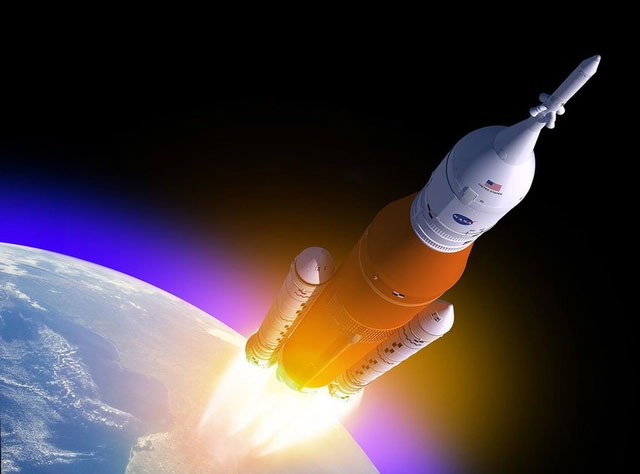
Simulation image of NASA’s SLS rocket. (Source: Mack Crawford / NASA Space Flight).
If all goes according to plan (meaning the Artemis I mission is successful), by May 2024, a crew of four astronauts could orbit the Moon on the Artemis II mission — marking the first time humans have traveled approximately 386,242 km to the Moon since 1972.
Furthermore, in 2025, NASA plans to execute the Artemis III mission, aiming to land humans on the Moon after a 53-year absence.
However, before any astronauts can set foot on Earth’s natural satellite, the SLS rocket and Orion spacecraft must successfully complete their steps.
SLS – Humanity’s Great Ambition
When the SLS launches, a massive roar will shake Merritt Island in Florida as four core stage rocket engines and two solid rocket boosters — the largest ever built — generate nearly 4 million kg of thrust. In the 500 seconds of ascent into space, the SLS will reach speeds of 28,002 km/h (equivalent to 7,778 meters/second).
Thanks to the solid rocket boosters on either side, the SLS will blast off the launch pad like a shuttle, soaring straight into the sky on a plume of bright, hot exhaust.
Orion is the first crewed spacecraft designed by NASA since the U.S. Space Shuttle’s first flight in 1981. The SLS is also the most powerful rocket ever built by NASA.
To escape Earth’s surface, the SLS faces more than just gravity. NASA’s Mega Moon rocket has encountered monumental challenges: years of delays, tens of billions of dollars in funding, relentless criticism, and the possibility that private American companies may soon launch similar massive rockets at lower costs.
However, as of now, the SLS is the only rocket capable of sending humans to the Moon. According to John Blevins, Chief Engineer for the rocket at NASA, “Since 2019, the super rocket SLS has represented a fundamental aspect of our unique human ambition.”
The core stage of the SLS rocket is manufactured at NASA’s Michoud Assembly Facility (pronounced MEE-shoo), located 24 km east of downtown New Orleans, Louisiana. This 174,015 square meter facility houses most of the SLS rocket production process for NASA.
In September 1961, NASA took over this facility, seeking a manufacturing site with deep-water port access to construct the Saturn V rocket for the Apollo Program. The core stage of the Saturn V was also produced here, as well as the iconic orange fuel tank of the Space Shuttle.
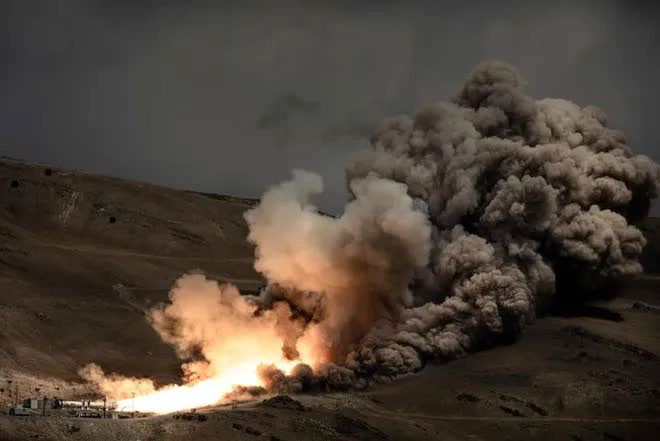
Fire and smoke billowing around Northrop Grumman’s test facility in Promontory, Utah, during the testing of one of the SLS’s solid rocket boosters. (Source: NATGEO).
The construction of the SLS core stage components is overseen by Boeing. At the Michoud Assembly Facility, Lockheed Martin is responsible for building the structural framework for the Orion spacecraft, which is then completed at Kennedy Space Center in Florida.
The two solid rocket boosters on either side of the SLS are manufactured by Northrop Grumman in various locations in Utah and then transported by train for assembly at Kennedy Space Center. The four RS-25 engines from the shuttle era that power the core stage are tested by Aerojet Rocketdyne in Mississippi.
In crafting the most powerful super rocket in NASA’s history, manufacturers must pay close attention to every detail. Just looking at the welds on the SLS core stage. Unlike conventional welds, those on the SLS are created through friction — using a 24-meter-wide welder, the largest ever built. This process produces stronger welds with fewer impurities and no filler metal required.
This ensures that the core stage can withstand the tremendous pressure when the SLS’s super-cooled hydrogen/oxygen fuel tank is compressed to more than 2.5 times the load it will experience during flight.
Legacy from the Space Shuttle
In some respects, the SLS is literally an engineering marvel ‘borrowing’ from the Space Shuttle. The first four launches of the SLS will utilize RS-25 engines that have flown in Space Shuttle missions — but have been refurbished and equipped with new flight controllers.
The solid rocket booster segments of the SLS also flew in Shuttle missions. This means that when the SLS launches, components from 83 different Shuttle flights (that have been improved) will fly alongside it.
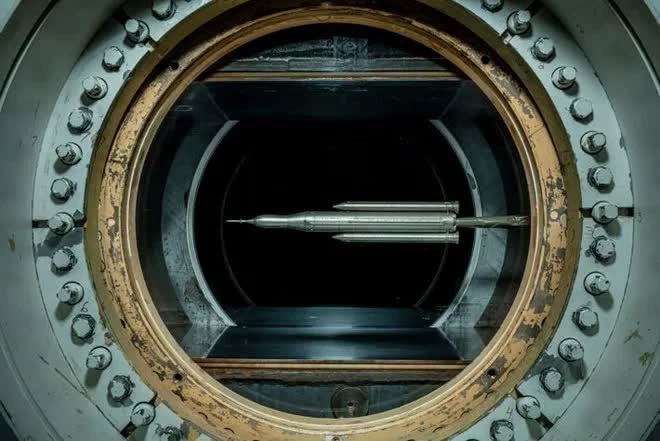
An early SLS model inside a 36 cm wind tunnel at NASA’s Marshall Space Flight Center in Huntsville, Alabama. Built initially in the late 1950s by the U.S. Army, this wind tunnel was used to test Saturn V rocket models from the Apollo Program and Shuttle. Source: NATGEO
However, creating a new launch vehicle from Shuttle-style hardware is not an easy process. In the 20th century, the Shuttle’s fuel tank was located beside its main engines, but on the SLS, those engines are positioned directly beneath the fuel tank.
To study how the SLS would operate during flight, engineers used a virtual rocket at NASA’s Marshall Space Flight Center in Alabama, southeastern USA.
Covered with metal boxes and accompanying white cables, the Systems Integration Laboratory contains a flight-standard replica of the SLS computer and avionics systems. Elsewhere in the laboratory, a system known as Advanced Real-Time Environment for Modeling, Integration, and Simulation (ARTEMIS) simulates SLS launches with extreme precision, down to the propellant in the rocket’s fuel tank.
ARTEMIS simulates the forces acting on the SLS rocket during launch, from aerodynamic drag to the temperature and pressure of the fuel tank, up to 10,000 times per second. In response, the SLS flight computer makes adjustments to the virtual rocket every 20 milliseconds. The SLS flight computer runs 50,000 lines of code.

At the Systems Integration Laboratory of NASA’s Marshall Space Flight Center in Huntsville, Alabama, a complex computer system is used to simulate hundreds of thousands of virtual SLS launches. (Source: NATGEO).
Together, the system has conducted hundreds of thousands of virtual SLS flights, addressing all kinds of issues raised by engineers on the digital rocket.
For Shaun Phillips, the lead software engineer for the SLS, the most ‘real’ moment came in March 2021 at NASA’s Stennis Space Center in Mississippi. During the testing of the SLS core stage, all four RS-25 engines ignited, producing a thrust of 725,747 kilograms for a full 8 minutes — the duration they would need to ignite the SLS in the actual Artemis I mission.
Phillips stated: “When the engines ignited, it felt like your heart wanted to leap out of your chest. The next time those engines fire for real for 8 minutes, that will be the moment SLS sends Orion straight to the Moon.”
The Rocky Road of SLS
Typically, in the journey of human space exploration, the path to creating SLS (or any launch vehicle) is rarely smooth.
The origins of the SLS rocket are believed to trace back to February 1, 2003, following the disaster when the Space Shuttle Columbia exploded during re-entry, killing its seven crew members.
In January the following year, a review board called for the retirement of the shuttles, and then-President George W. Bush outlined a new plan to send astronauts to the International Space Station (ISS), the Moon, and Mars.
This initiative, formalized as the Constellation Program in 2005, called for the design of a crew capsule named Orion, a lunar lander, and a new rocket line. However, the Constellation Program quickly became costly and delayed, and in February 2010, the Obama administration proposed canceling it.
This move raised concerns in the U.S. Congress, especially since Constellation had maintained contracts with NASA to support thousands of high-skilled, high-paying jobs across the country.
In response, Congress funded two different rocket programs: the Commercial Crew Program — which has contracts with SpaceX and Boeing to send astronauts to the ISS; and the SLS manufacturing program.
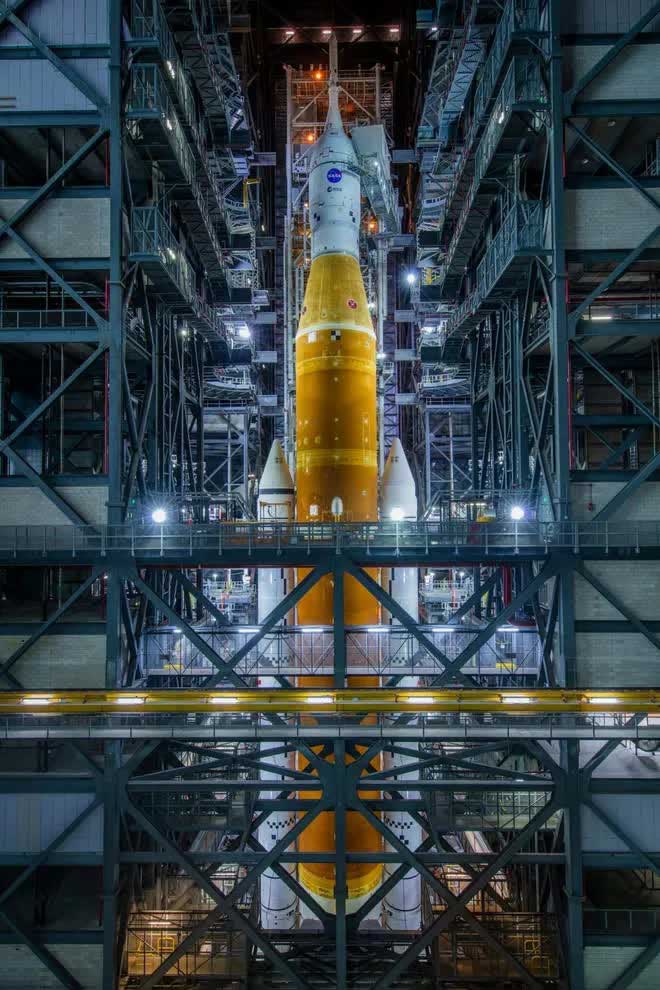
SLS and Orion at Kennedy Space Center. (Source: DAN WINTERS / NATIONAL GEOGRAPHIC).
Although SLS is finally ready to launch to the Moon soon, it has paid a hefty price. For the SLS manufacturing team in its early days, difficulties and challenges were everywhere.
A tornado tore through the Michoud Assembly Facility in 2017, damaging two buildings; furthermore, Hurricane Ida ripped off the roof in September 2021, and the COVID-19 pandemic caused significant delays in the SLS construction timeline.
Not stopping there, according to NASA’s Office of Inspector General, the agency lost years fixing technical errors in the welding and manufacturing of the solid rocket boosters.
According to a key timeline from NASA in 2014, SLS was estimated to cost about $9.1 billion to design and manufacture for the launch planned for November 2018. By June 2022, the U.S. Government Accountability Office found that those costs had risen to nearly $11.8 billion, following a three-year delay due to the pandemic.
“It was a very painful time. In the end, SLS overcame the worst nightmare. Now, it stands tall on Launch Pad 39B at Kennedy Space Center, waiting for its launch day.” – Lori Garver, former Deputy Administrator of NASA from 2009 to 2013.
In March, NASA’s Office of Inspector General estimated that the overall Artemis Program would cost about $93 billion from October 2011 to September 2025, including $4.1 billion for each SLS launch (for at least the first four SLS launches) – according to Paul Martin, Inspector General of NASA’s Office of Inspector General.
Having gone through countless difficulties, SLS today stands on the launch pad, waiting for takeoff. While SLS’s success in spaceflight is anticipated, for those connected to it, the emotions that arise will be both proud and anxious. Why?
The “Invisible” Legacy of NASA’s Most Powerful Rocket
According to NASA, it will take even more time to complete upgraded versions of the SLS rocket.
Currently, the SLS rocket (in its initial version called Block 1) has a launch thrust greater than that of the Saturn V rocket from the Apollo Program.
The upper stage of the SLS is a temporary model with an engine that will only fly to support three Artemis missions (Artemis I, II, III).
Starting with Artemis IV, the SLS will utilize a more powerful engine, four “Exploration Upper Stage” engines that will enable SLS to launch from 27 tons to at least 38 tons of cargo. Subsequently, upgraded versions of the SLS rocket will be equipped with improved solid rocket boosters, raising the payload to the Moon to over 43 tons.
NASA will need all this additional capability of SLS to build a space station in lunar orbit, as planned after Artemis III is completed.
The NASA space agency also hopes to develop a research station on the Moon, using the final configuration of SLS called “Block 2,” which David Beaman of NASA, Director of SLS Engineering & Integration Office, refers to as “The Mother of All Space Launch Vehicles.”
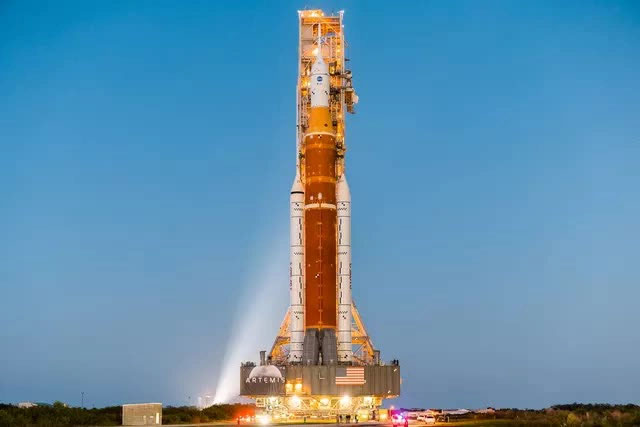
History will have much to say about SLS and humanity’s next space adventure. (Source: NASA).
SpaceX, the rocket manufacturing company founded by Elon Musk, may not agree with that. In 2018, the company launched its own heavy-lift rocket, the Falcon Heavy, which can partially be reused and can launch about 18 to 22 tons to the Moon at a minimum cost of $97 million.
SpaceX is also building an even larger rocket called Starship — unlike SLS, designed to be fully reusable. If Starship operates, it will allow for launching large payloads at unprecedented low costs. In the long run, SpaceX aims to use this rocket to establish a city on Mars.
However, the Starship remains just a prototype, and its full potential will only be realized if it can refuel in orbit, something that has never been done before.
NASA officials emphasize that there is no competition between NASA and SpaceX, as both rockets (SLS and Starship) are critical to the success of the Artemis Program. The astronauts of the Artemis III mission landing on the Moon will leave Earth in the Orion spacecraft launched by SLS; and then transfer to the upper stage of Starship (the spacecraft of the same name from the Starship system) to land on the lunar surface.
The success of Starship also depends on SpaceX’s ability to land and relaunch the massive rocket.
Regarding the first flight of SLS, according to the plan, less than 2 minutes into the flight, the two solid rocket boosters of SLS will fall into the Atlantic Ocean, and unlike shuttle boosters, they will not be recovered. About 8 and a half minutes after the journey, the core stage of SLS will separate and fall into the Pacific Ocean. And just over 2 hours after launch, the upper stage of SLS will separate from the Orion crew capsule and enter a solitary orbit around the Sun.
Each time parts of SLS separate, it is a demonstration of the success of SLS’s Orion launch mission. “Thinking about the fate of the SLS rocket parts is a bittersweet feeling. You won’t be able to see and recover those hardware parts, but everyone understands that thanks to them, Orion can fly to the Moon. That invisible legacy is what we will always remember,” said Boeing engineer Amanda Gertjejansen.
History will have much to say about SLS and humanity’s next space adventure.


















































